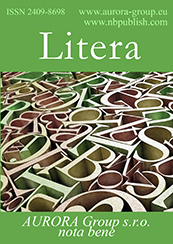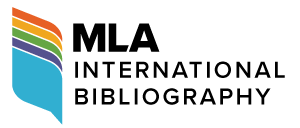Psycholinguistics
Reference:
Prihod'ko , V.K. (2025). Types of Emotives in Artistic Text (Based on M.Yu. Lermontov's Poem "Demon"). Litera, 5, 1–13. https://doi.org/10.25136/2409-8698.2025.5.74232
Abstract:
The article examines the category of emotivity through emotive words, metaphors, and emotive descriptions used in literary texts. It attempts to explain the essence and functioning of emotives of different types based on the material from M.Yu. Lermontov's poem "Demon" according to the typology proposed by the author. This typology was developed and tested by the author of the article previously on dialectal material. The typology has not been studied in relation to the poetry of M.Yu. Lermontov before. The object of the study is the category of emotivity, which is understood as the verbal representation of the emotional world of characters in the literary text. The subject of the study is the linguistic means of expressing emotions in the poem "Demon" by M.Yu. Lermontov. The relevance of the study is ensured by the extraordinary interest of scholars in the category of emotivity and the ways it is expressed in literary texts. The methods used in the work include analytical and descriptive methods, as well as semantic and contextual analysis of emotive contexts based on the main principles of linguistic analysis of literary texts: the principles of historicism, coordination of the general and the specific, the principle of semantic opposition, and the principle of associative dominance. The novelty of this research is determined by the fact that no similar analysis has been conducted based on the material of M.Yu. Lermontov's idiolect so far. The poem "Demon" by M.Yu. Lermontov has not been studied in terms of emotivity from this perspective either. In scientific literature, it is common to discuss psychological aspects and the psychological foundations of the mythological image of the Demon. In this study, the artistic style of language, which creates diverse psychological and speech portraits of characters, is chosen as the material for examining emotives in semantic and pragmatic aspects. The identified and described emotives express "living," "painful," and "dead" emotions of literary heroes, vividly reflecting their inner world and experiences, and are also interesting in terms of the communicative act, during which the writer as the creator of the artistic work interacts with an intelligent, thinking reader.
Keywords:
M.Yu. Lermontov, poem, emofalsified, emoviolative, emotanatative, emovitative, emotives, psychologism, emotive meaning, emotionality
Comparative-historical studies of literature
Reference:
Martirosian, G.E. (2025). Artistic Representation of the Past in Afrofuturist Novels from Nigeria and the United States. Litera, 5, 14–24. https://doi.org/10.25136/2409-8698.2025.5.74309
Abstract:
This study focuses on the artistic strategies of representing historical past in two Afrofuturist novels: «Kindred» by Octavia Butler and «War Girls» by Tochi Onyebuchi. The author examines how these texts, rooted in distinct geographical and cultural contexts—African American and Nigerian—conceptualize the past as a constituent of collective memory, historical trauma, and cultural identity. Special attention is paid to the integration of the past into the structure of speculative fiction, its narrative functions, and its role in shaping future imaginaries. The comparison of the two novels reveals both shared tendencies within Afrofuturist writing and region-specific approaches to historical material and postcolonial or discriminatory experiences. The research employs comparative literary analysis, narratological tools, and the methodology of Postcolonial Studies. An anthropological perspective is applied to account for localized practices of collective memory, cultural coding, and divergences in historical narratives in Nigeria and the United States. The theoretical framework is informed by contemporary Afrofuturist scholarship. The past is interpreted as a narrative-generative element within the texts. This article presents the first comparative analysis in Russian literary studies of past representation in Afrofuturist fiction from Nigeria and the United States. It identifies a key distinction: in the U.S. Afrofuturist tradition, the past is portrayed as trauma requiring emotional reconstruction, whereas in the Nigerian tradition, it emerges as a cyclical history necessitating caution and reinterpretation. The study delineates divergent narrative strategies—from direct temporal immersion in the history of slavery (U.S.) to allusive transpositions of civil war into a futuristic setting (Nigeria). It demonstrates that speculative fiction operates in both contexts as a tool for cultural and political reflection. The findings contribute to refining the conceptual apparatus of Afrofuturist criticism and open new directions for Afrofuturist research within Russian humanities.
Keywords:
sankofa, Comparative Literary Studies, represenatation of the Past, postcolonial novel, U.S., narrative memory, Nigeria, Africanfuturism, Afrofuturism, Black futurism
Journalism
Reference:
Nurbagomedova , Z.R. (2025). Narrative component in the structure of politicians' image. Litera, 5, 25–32. https://doi.org/10.25136/2409-8698.2025.5.74366
Abstract:
The subject of the research is the structure and functions of narrative as a tool for shaping political image in the media space, including its substantive, structural, and symbolic characteristics. The object of the study is political communication in modern mass media, particularly in the context of transnational media discourse. The author examines various aspects of the topic, such as the typology of narratives (personal, public, meta-, and conceptual), their plot structures, emotional carga and symbolic potential. Speech strategies for influence (enhancement, degradation, phantom threat, forecasting) and their role in constructing a positive or negative image of a politician are also analyzed. Special attention is paid to comparing interpretations of the same political figures in different ideological, cultural, and national media contexts, which helps to reveal the dependence of media narratives on the editorial policy and political positions of the publication. The study employs methods of critical discourse analysis and qualitative content analysis. The analysis is based on a structural-semantics approach to media texts containing narrative constructions and aims to identify speech strategies for shaping political image in publications of foreign media outlets. The main conclusions of the conducted research are the provisions that narrative strategies are one of the central mechanisms for forming a political image in the media environment. The novelty of the research lies in the comprehensive systematization of types of narratives and the identification of stable models of their use in the discourse of foreign media. A significant contribution of the author to the study of the topic is the identification and description of four dominant strategies of narrative influence: enhancement, degradation, phantom threat, and forecasting. The analysis of specific media cases has shown that narratives can set both positive and negative perceptions of the same politician, depending on the ideological context. The results obtained have practical significance for media strategies, political PR, and educational programs in the field of media and political communications.
Keywords:
media interpretation, political image, narrative strategies, storytelling, symbolic representation, media discourse, politician's image, narrative, critical discourse analysis, political communication
Literary criticism
Reference:
Belavina, E. (2025). Poetic writing in contemporary French scientific thought. Litera, 5, 33–45. https://doi.org/10.25136/2409-8698.2025.5.74356
Abstract:
The article is devoted to modern theoretical approaches to the study of poetic writing. ‘French theory’ developed in dialogue with the works of Freud, Husserl, Heidegger, Merleau-Ponty, Benveniste and Saussure. Criticism of Saussure's dualism of the sign and logocentric models can be found in Merleau-Ponty, Benveniste and Meschonnic. Meschonnic's works on the anthropological theory of rhythm are not well known in our country. The aim of this article is to arouse the reader's interest in the anthropological theory of sound by pointing out its Russian sources and integrating it into the conceptual apparatus of philosophy (Derrida, Merleau-Ponty) and linguistics (Benveniste, Saussure). The key concepts for Meschonnic are the subjectivity and historicity of writing, which allows her to study the processes of signification (writing and interpretation) in the light of the anthropological turn in science. The concepts of trace, writing, voice, and presence are analysed on the basis of a comparative analysis of the texts of Debray's "Mediology", Derrida's "Freud and the Writing Scene", and Meschonnic and Dessons's "A Treatise on the Rhythm of Poetry and Prose", among others. The field of interdisciplinary research of writing as a transmission and preservation of experience is supplemented by raising the question of the material medium. For the first time an attempt is made to combine the conceptual apparatus of mediology (communication and transmission), phenomenology (trace, presence, voice, phusis-writing, logos-writing) and anthropological theory of rhythm (rhythm, subjectivity, historicity). For French verse studies (sillabic), the novelty of Meschonnic's approach lies in the analysis of the system of accents and sound repetitions, genetically connected with the works of Russian formalists (in particular, the comparativist E. Polivanov). This component of Meschonnic's works paradoxically complicates its reception in Russia, as it creates the illusion of familiar material. The results obtained help to fit Meschonnik's theory into the Russian and European scientific apparatus and show its novelty and effectiveness in combining the theory of rhythm with the consideration of the register of transmission.
Keywords:
voice, subjectivity, historicity, phenomenology, signifying modes, phusis, Meschonnic, anthropological rhythm theory, trace, contemporary poetic writing
Translation
Reference:
Orlova, V.V. (2025). In search of an alternative to note-taking: an experimental study of the use of mnemonic devices in consecutive specialized interpreting. Litera, 5, 46–61. https://doi.org/10.25136/2409-8698.2025.5.74382
Abstract:
The subject of this study is the completeness of consecutive specialized interpreting performed using three different methods of information fixation: note-taking, traditional memorization, and memorization with the aid of mnemonic devices. Given the limitations on the use of note-taking in consecutive interpreting, there is a need for alternative methods of information fixation. As a potential solution, this study proposes considering the use of mnemonic devices, particularly the method of loci, which utilizes the resources of working memory. The research aims to examine the cognitive mechanisms underlying the processes of information fixation and reproduction in consecutive interpreting. The goal is to establish the possibility of using mnemonic devices as an alternative to traditional note-taking, thereby ensuring a sufficient level of fixation of incoming information and contributing to the achievement of semantic equivalence in consecutive interpreting, especially in situations where the use of note-taking is complicated or impossible. To achieve this goal, a methodology of quantitative assessment of the completeness of consecutive translation is used, where the basis of the metric constitutes the completeness of reproduction of the source text. The study conducts three memory tests with an experimental group of interpreters: with fixation of auditory information using note-taking, with traditional memorization, and with memorization using the “method of loci” technique. The scientific novelty of the research lies in the fact that, for the first time, the quantitative component of the completeness of interpreting performed using different methods of fixing auditory information is determined. Obtaining such data makes it possible to objectively assess the advantages of one or another method of fixation, to identify the individual cognitive characteristics of each interpreter with regard to one or another method of fixation, and to optimize training programs for students of translation specialties. The main result of the work is the confirmation of the hypothesis that the method of loci can be used as an alternative way of fixing information in consecutive specialized interpreting, including cases with abstract material. The results of this study open new perspectives in improving the efficiency of consecutive specialized interpreting in conditions where note-taking is difficult or impossible to use.
Keywords:
quantitative quality assessment, translation accuracy, working memory, method of loci, translation completeness, mnemonic devices, note-taking, interpreting, translation studies, translation quality assessment
 This work is licensed under a Creative Commons Attribution-NonCommercial 4.0 International License.
This work is licensed under a Creative Commons Attribution-NonCommercial 4.0 International License.
 Eng
Eng













 © 1998 – 2025 Nota Bene. Publishing Technologies. NB-Media Ltd.
© 1998 – 2025 Nota Bene. Publishing Technologies. NB-Media Ltd.




